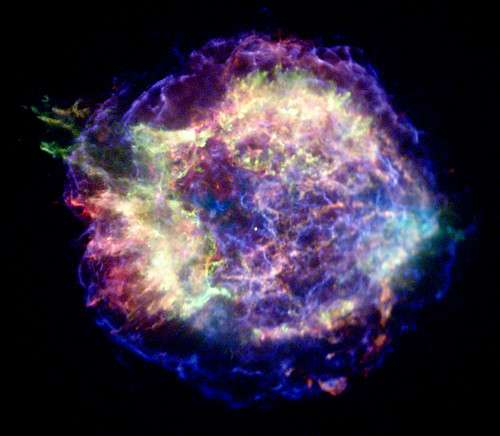Throughout May and June, we are inviting people throughout the Smithsonian to talk about photography and astronomy. This is the first installment from Megan Watzke, Press Officer at the Smithsonian Astrophysical Observatory. Most people think of a telescope as something in a backyard or the dome at the local planetarium. And it’s true that many telescopes are designed to enhance our ability to observe the light we see with our human eyes. But that’s just one kind of telescope that detects just one type of light. It turns out that light takes on many forms—a majority of which cannot be seen with our eyes. Most people know this on an intuitive level since they know they can get sunburned from ultraviolet (or "UV") radiation that we can’t see. And the Universe tells its story through all of these different types of radiation from radio to infrared to X-rays and beyond. Therefore, in order to really understand the cosmos, astronomers need all different kinds of telescopes. One way to think about this is the following analogy. Imagine you have never been to a baseball game, nor have you ever even heard of the sport. Then suppose someone takes you to a game, but has blocked your vision so you could only see a small sliver down the third base line. From that narrow vantage point, you are supposed to figure out the rules of the game, the score, etc. Pretty tough, right?

Well, that’s what astronomers would be doing if they tried to study the Universe only with telescopes that could see light detectable by the human eye (what scientists refer to as "visible light"). Just as it’s a lot easier to figure out the rules of baseball when you see the entire field, so too is the Universe much more understandable if you can see the whole cosmos. If these other kinds of telescopes are important, then why haven't more people heard about them? Well, humans have visible light "telescopes": their eyes. Galileo built on this fact in 1609 and work in "optical" astronomy has progressed from there.
Observing in other types of light, or wavelengths, however, is a lot more complicated. For example, X-rays from space are almost entirely absorbed by the Earth's atmosphere. Therefore, we couldn’t start X-ray astronomy until humans figured out how to launch satellites and rockets into space in the middle of the 20th century. That’s where the Chandra X-ray Observatory comes in. Launched aboard the Space Shuttle Columbia in 1999, Chandra is one NASA’s "Great Observatories." This was a program started by in the 1980s to launch four major telescopes into space—each of which would look at a different type of light. You may have heard of the one that looks at visible light—it’s named Hubble. The others are the Compton Gamma-ray Observatory and the Spitzer Space Telescope that looks at infrared. But back to Chandra. When objects get very hot (or, by extension, very energetic), they give off X-rays. Some of the most intriguing objects in the Universe—things like black holes, exploded stars, clusters of galaxies—reveal much about themselves through X-rays. And how do we make images of X-rays, which are invisible? We do this by assigning colors to different ranges of X-rays that Chandra detects. Typically (but not always), we will make the lowest-energy X-rays Chandra has detected red, the medium range will be green and the most energetic X-rays are blue. When you combine these layers together, you get an X-ray image.  Next time, we’ll go into some of the details of how you make images when your X-ray camera is thousands of miles above the Earth.
Next time, we’ll go into some of the details of how you make images when your X-ray camera is thousands of miles above the Earth.
Megan Watzke of the Smithsonian Astrophysical Observatory.
Produced by the Smithsonian Institution Archives. For copyright questions, please see the Terms of Use.

Leave a Comment